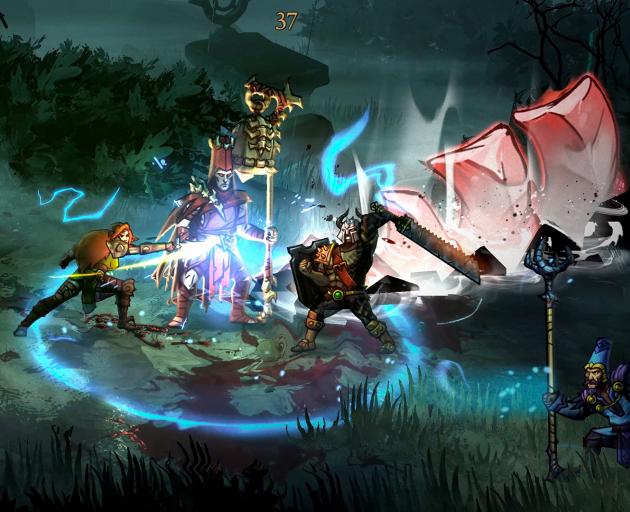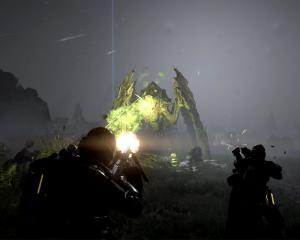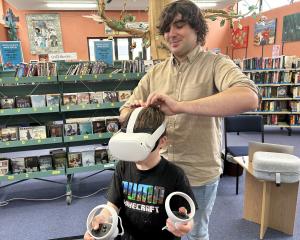
We live in an interesting new era of game releases. Thanks to the advent of digital distribution, if there’s something wrong with your game, no problem; just fix it with an update. This allows games to be supported easily and negates the cost of physical production.
It has also, however, led to an unfortunate practice of releasing games in questionable states. Afterwards, they get a steady stream of updates over the next few years to bring them up to scratch, positively stylised as a "roadmap", with the hope the promise of content is enough to overcome the actual lack of it.
Blightbound was released on Steam in early access in July last year and now a year later, they’ve pushed the 1.0 update along with a PS4 and XB1 release. It’s an action role-playing game with a focus on multiplayer co-operative dungeon crawling, containing distinct classes with their own play-styles. You level up your heroes and craft equipment to boost their stats, while trying to save more heroes to add to your roster.
The game goes for a hand-painted paper cut-out aesthetic which I really like, with some entertaining bloody theatre to the combat. Each hero class plays very differently. Warriors are your basic tanks, assassins are damage dealers, and mages are ranged healers. The different classes are unique, but all have a similar play formula. You have your basic attack, a dodge skill, two basic abilities, one resource-based skill, and an ultimate. The skills might change between different heroes, but this formula remains the same.
Each class has a resource which they have to manage effectively. For example, assassins hit foes multiple times to charge a combo meter, then spend it all for a devastating attack.
After spending your resource, you also charge your ultimate ability. This simple loop of resource generation and expenditure keeps you engaged, offering multiple tactical decisions per room.
Despite this variety, the main issue around the game is the general lack of content and some poor design choices, leading to little replay value. There’s only nine missions total at the moment, with little in differences to keep things fresh. It’s always the same objectives and the same boss fights at the end. There are 21 heroes in all, but they all play very similarly to other heroes in the same class; in most cases, only the basic abilities are changed. You can complete "bounties", little missions which earn you some crafting materials, but unlike in other games, you can’t swap these missions out for others until you beat them — so good luck if you’re like me and have to beat one at the hardest difficulty ... twice.
Difficulty settings are an issue in general. They’re randomly generated. On the surface it’s a decent idea, leading to picking different missions to suit your level. In reality, it always seemed to give me an impossible difficulty on the missions I needed to do for hero stories. Seeing as the main hook after collecting heroes is the constant beating of high-difficulty missions, having it be completely random seems odd, to say the least. The game also wants you to play around with all the heroes, but having a low-levelled hero in a high-levelled mission is a fool’s errand, especially if you’re playing solo.
If you’re going to get this game, pick up two more copies for your friends. While it is possible to play this game solo with bots or online with random people, each of these has their unavoidable downsides. The bots are about as useful as wet carpet, constantly just rushing in and dying if any foe is slightly tougher than usual. If you go down, they’ll literally die to get you back up, which leads to a lot of missions failing during boss fights because you made one mistake. That’s a 30-minute mission down the drain because I went left instead of right. The game is also very difficult on the higher levels of play, making human players near mandatory.
Online with random people is always a roll of the dice, but in Blightbound it’s painfully slow. Since you need a mage, warrior, and assassin, if no-one is queuing for mages that day, good luck finding a game. With friends, you can get into games faster and co-ordinate better in the fights.
Early on the game crashed a lot, matchmaking didn’t work at all, the tutorial disconnected from the server on multiple attempts, and some maps were impossible to play with bots, due to them not recognising that pressure plates existed. I was going to write this game off as "unfinished", but it only took a few days before an update arrived to remedy all of this. If nothing else, it shows the devs are at least committed to updating Blightbound into the future.
Maybe it’ll yet gain a loyal following and "hidden gem" status. For now though, it’s too simple and bland to make a splash; there’s technical and design issues to iron out, playing solo is next to impossible and its repetitive nature will push some away.
- Michael Robertson












